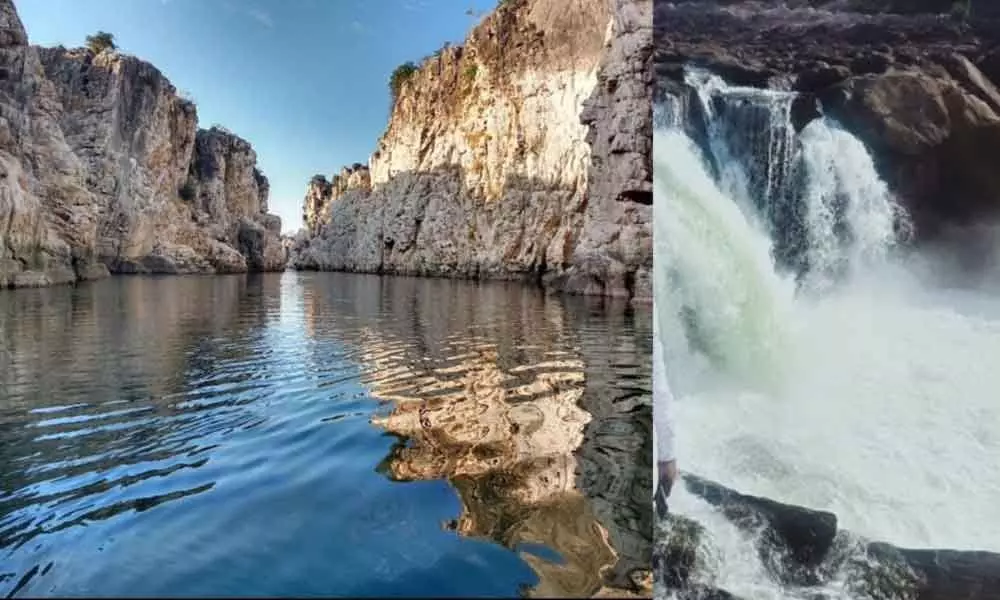Live
- Gentle in manner, resolute in convictions: Sonia Gandhi pens emotional note for Dr. Manmohan Singh
- 2024: A landmark year for India's defence achievements and breakthroughs
- 2025 Horoscopes: Insights and Guidance by Pt. Umesh Chandra Pant
- Osamu Suzuki was a legendary figure in global auto industry: PM Modi
- “AMOEBA”: Celebrating the Journey of Telugu Entrepreneur Sri Motaparti Siva Rama Vara Prasad
- Sachin Khedekar recites a poem from director Feroz Abbas Khan’s powerful new play, ‘Hind 1957’
- NABL-QCI appoints Dr. Sandip Shah as chairperson
- Centre transfers Rs 2.23 lakh crore for 1,206 schemes under Direct Benefit Transfer
- BGT 2024-25: Watching Konstas bat reminds me of Symonds, says Hayden
- 75 iconic lighthouses in India saw more than 10 lakh visitors till September
Just In
River Narmada's Beautiful Marble Rocks


The Narmada River flows through Madhya Pradesh, Maharashtra and Gujarat and is one of the seven most sacred rivers in India. It is also called the Rewa and was previously known as Nerbudda, is a river in central India , after the Godavari and the Krishna.
The Narmada River flows through Madhya Pradesh, Maharashtra and Gujarat and is one of the seven most sacred rivers in India. It is also called the Rewa and was previously known as Nerbudda, is a river in central India , after the Godavari and the Krishna.
The splendid Narmada River's path flows 1,077 km through what was earlier India's largest state, Madhya Pradesh. The Narmada has grown and shaped itself as a meandering river with multiple picturesque falls. The famous Marble Rocks are within a gorge along part of the river that lies close to the city of Jabalpur. Earlier, the gorge was said to be so narrow in size that monkeys could cross over from one side to the other. The narrow portion was locally known as 'Bandar Kudni' - the place where monkey's can jump across.
The white marble on either side of the gorge are rich in magnesium, but not as hard as the marble in other areas As a result, the Narmada marble can be carved and is as soft as soap stone. This softness allows them to be carved into beautiful artifacts. The area also contains other shades of marble as well - these are shades of blue and brown coloured marble.
A visit to see the Marble Rocks is high on the list of tourists. A cable car takes visitors across the gorge, where a large number of row boats wait to take people for guided tours of the river downstream, to see the waterfalls. It has been said that the view of the rocks rising from the waters is similar to that of the Grand Canyon.
The most popular and the best time for boating on the river is during full moon and bathing and boating are considered sacred on the night of the full moon in the month of Kartik.
Boating during 'Sharad Purnima' at the time of the Kojagari Lakshmi Puja, is considered a way of healing for both the body and soul.
One of the most enjoyable boat rides is to see the Dhuandhaar Falls located in Bhedaghat, these falls drop 30 ft below and are the biggest falls on the Narmada. The Narmada River, while making its way through the Marble Rocks, narrows down and then plunges in a waterfall named �Dhuandhaar' - the name means Dhuan (smoke) and Dhar (flow). The river's plunge, creates a cloud of mist, so powerful that its roar can be heard many miles away.
The best time to visit the Dhuandhar falls is during the 'Narmada Mahotsav, celebrated during 'Sharad Purnima' - when the rays of the full moon, make the white marble shine like silver. Before sunset, boat rides from Dhuandhaar towards the valley of white marble, offers visitors a pleasure ride in the valley of white marble, which takes on a golden hue during sunset.
There is a Cable Car service at the waterfalls, which can be accessed from both the east and west banks of the Narmada. To see the west side one will have to take the Cable Car Service available at the entrance gate of Bhedaghat. The ropeway facility starts from the eastern banks, crosses the river and drops you at the west bank of the river. One can access the Dhuandhar waterfall from the east bank as well as from the west bank of Narmada River. The ropeway facility starts from the eastern bank of Narmada River, crosses the river and then drops you at the west bank . The Cable Car facility charges Rs 85/- per person for one complete trip, but do remember that it is closed for lunch between1.30 to 2 pm.
From Jabalpur, one must definitely make a point of seeing the Chausath Yogini Temple, which is one of the oldest heritage sites in India. It is located in Bhedaghat near the Marble Rocks of Narmada, about 5 km from Jabalpur. It was built in the 10 th century AD, by the rulers of the Kalachuri kingdom, who mainly used local granite. The temple though different in subject, loosely resembles the styles of the temples of Khajuraho and is dedicated to Goddess Durga, along with her 64 yoginis, or female attendants. The temple is partially damaged, but is an amazing structure, and well worth seeing.
The Chausath Yogini Temple is located on a hill top. There are more than 150 steps that one has to climb to reach the temple, which looks beautiful in the sunlight.
Shona Adhikari is a lifestyle
and travel columnist

© 2024 Hyderabad Media House Limited/The Hans India. All rights reserved. Powered by hocalwire.com






